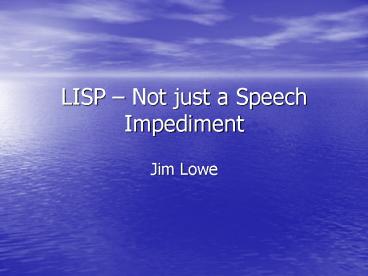LISP - PowerPoint PPT Presentation
1 / 9
Title:
LISP
Description:
Initial development begins at the Dartmouth Summer Research Project in 1956 by Dr John McCarthy. ... was a mathematical concept applied to a computer. Object ... – PowerPoint PPT presentation
Number of Views:52
Avg rating:3.0/5.0
Title: LISP
1
LISP Not just a Speech Impediment
- Jim Lowe
2
Brief History of LISP
- Initial development begins at the Dartmouth
Summer Research Project in 1956 by Dr John
McCarthy. - At the time, Fortran was the only high level
programming language available. - Dr. McCarthy and his colleagues were interested
in producing a language more suited for
manipulating data in a similar manner to human
thought.Artificial Intelligence. - Language development was completed at MIT and was
made available to the general computer science
community in 1963.
3
Innovations of LISP
- First functional language.
- Emphasis is on the evaluation of expressions
rather than the execution of commands. - Recursion
- The concept of a function calling itself until a
predefined base case was reached was a
significant step forward in CS. LISP memory
management was developed to allow for recursion. - Recursion was a mathematical concept applied to a
computer. - Object Orientation
- The basic unit of data in LISP is a list. This
data structure is ideally suited for definition
of a weak typed object. For example, animals
could be defined as - (animals (cat brown) (dog white) (bird purple))
- (animals (cat brown dumb) (dog white smart))
4
Inovations of LISP (cont.)
- Object Orientation (cont)
- This concept was developed to provide for
programming a computer to think like a human - Functions can be defined as objects and passed as
arguments. - Garbage Collection
- Memory management was handled by the interpreter.
- Conditionals
- A conditional is an if-then-else construct. We
take these for granted now. - FORTRAN used GOTO
- Variables
- In LISP all variables are pointers, this allowed
for the reduction of data storage requirements
for recursive functions.
5
LISP BNF Grammar
- All LISP expressions built from simple grammar
rules - Atom NULL OR Letter OR Number
- Letter A OR B OR C.OR Z
- Number 0 OR 1 or 2 OR 9
- S-Expression Atom OR (S-Expression .
S-Expression) OR List. - List (S-Expression )
- NULL
- Atoms can be used to represent values and passed
as these values. For example we may need to
define PI to equal 3.1415 or FRED to equal
Fredrick the 3rd of Nowhere. To do this, LISP
binds a value to the variable representation.
With the function setq.
6
Functionality of LISP
- LISP can be compiled or interpreted.
- Early LISP was interpreted only. This was of
particular importance due to a complete lack of
computer operating system standardization. - Later versions (c. 1968) provided for compilation
to take advantage of LISP machines. LISP
Machines were computers built solely to execute
LISP instructions. - Variable visibility is limited to descendants
from point of definition - There is no real distinction between read-time,
compile-time, and runtime. - You can compile or run code while reading, read
or run code while compiling, and read or compile
code at runtime.
7
LISP today
- LISP is currently standardized in many different
forms. - ANSI standard X3.226
- ISI (International Standards Institute)
13816.1997 - Many of the descendants of LISP are also
standardized. - Scheme Educational and Research language.
- Arc A modern LISP derivative.
- AutoLISP A dialect used for CAD applications.
- Dylan An object-oriented dialect of LISP.
- Emacs LISP Text editor extension language.
8
Advantages of LISP
- Programs are easy to test due to interactive
interpreter environment. - Portable across hardware platforms with supported
interpreters. - Clear and concise syntax and semantics.
- Automatic memory management and garbage
collection. - Packaging of programs into modules.
- Flexible data structures.
- Object oriented capability.
9
Disadvantages of LISP
- Limited availability of compilers Increased
program size and run time. - Cross platform compatibility requires multiple
interpreter environments. - Small install base creates limited audience for
programs. - Other computer programmers make fun of you
because you talk funny.































